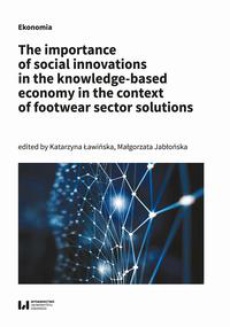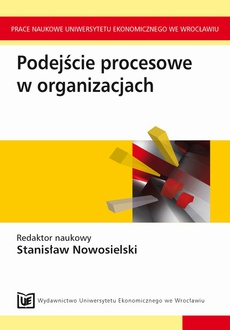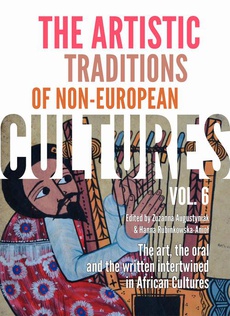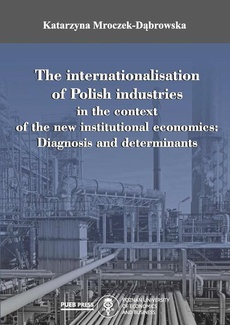POLECAMY

The importance of social innovations in the knowledge-based economy in the context of footwear sector solutions
Redakcja:
Wydawca:
Format:
ibuk
The prepared scientific monograph entitled The importance of social innovations in the knowledge-based economy in the context of footwear sector solutions is an attempt to further exemplify social innovations by identifying real links between social need and a specific good, service, method and process, in the context of solutions used in the footwear industry. Poland is one of the leading European footwear manufacturers, ranking 7th in terms of production volume in the EU, with a market share of 2.5%. In addition, strong competition is observed in the industry, which is conducive to the emergence of new innovations. The work contains theoretical and practical references to innovations in the industry, such as examples of modifications of footwear materials that have been used in business practice, and their measurable effect is to improve the comfort of using footwear. The authors refer to the environmental aspects of innovation, indicating the directions of utilization of production residues of the footwear and tanning industry, including composites, granules, and biostimulants for plants. The subject matter taken up in the monograph is an important contribution to the development of further scientific research covering the footwear industry and its importance in developing social innovations in Poland and the world. Based on the obtained research results and statistical data analysis, we attempted to outline the prospects for the development of social innovations in the footwear industry until 2050. The book can be an interesting study for practitioners and theoreticians, particularly for scientists representing disciplines such as economics and finance, management sciences, materials engineering, or entrepreneurs looking for opportunities to finance innovation in various areas.
| Rok wydania | 2024 |
|---|---|
| Liczba stron | 292 |
| Kategoria | Publikacje darmowe |
| Wydawca | Wydawnictwo Uniwersytetu Łódzkiego |
| ISBN-13 | 978-83-8331-402-0 |
| Numer wydania | 1 |
| Język publikacji | angielski |
| Informacja o sprzedawcy | ePWN sp. z o.o. |
Ciekawe propozycje
Spis treści
| Introductory Notes | 9 |
| Chapter | 1 |
| The Importance of Social Innovation in the Knowledge-based Economy | 11 |
| 1.1. The Importance of Social Innovation in the Innovation Ecosystem | 11 |
| 1.2. Innovation Booster in the Enterprise | 18 |
| 1.3. Social Innovation Booster Pre-conditions and Implementation Prospects | 29 |
| 1.4. The Role of Social Innovation in Ensuring the Societal Security | 32 |
| 1.5. Possible Funding Sources for Social Innovation in the Programming Period 2021–2027 | 34 |
| Chapter | 2 |
| Footwear Innovation to Improve the Comfort of Use | 51 |
| 2.1. Definition of the Comfort of Footwear Users and Improvement Prospects | 51 |
| 2.2. Antimicrobial Protection | 58 |
| 2.3. Modification of Footwear Materials By Means of Natural and Safe Substances of Antibacterial and Antifungal Properties | 60 |
| 2.3.1. Safety of cinnamon, peppermint and oregano essential oils in the context of toxic effects on human health and the natural environment. Comparison with commercial preparations | 60 |
| 2.4. Encapsulation as a method of extending the activity of active ingredients applied to light industry materials | 79 |
| 2.4.1. Basic Encapsulation Concepts | 79 |
| 2.4.2. Microencapsulation Techniques | 80 |
| 2.4.3. Encapsulating/Coating Materials | 82 |
| 2.4.4. Release Methods | 84 |
| 2.4.5. Application of Microcapsules to Light Industry Materials | 85 |
| 2.4.6. Development of the Microencapsulation Method for Cinnamon Oil | 87 |
| 2.4.7. Application of Microcapsules to Carrier Materials (Leather, Cotton) | 91 |
| 2.4.8. Microbiological Activity of Materials Modified with Microcapsules Containing Cinnamon Oil | 91 |
| 2.4.9. Durability of Carrier Materials Modified by Means of Microcapsules | 99 |
| 2.5. Self-cleaning Properties of Light Industry Materials Exemplified by Cotton Fabric and Velour Leather – Inspired by Nature | 100 |
| 2.5.1. The Method of Obtaining Textile Fabric with Self-cleaning and Antimicrobial Properties | 102 |
| 2.5.2. Characterisation Methods | 103 |
| 2.6. Auxetic Structures Used in Footwear and Clothing Materials | 112 |
| Chapter | 3 |
| Utilisation of Production Residue from the Footwear and Clothing Industry | 121 |
| 3.1. Characteristics of the Footwear and Clothing Industry in terms of Waste Management | 121 |
| 3.1.1. Implementation of the Principles of Sustainable Development | 127 |
| 3.1.2. Utilisation of Production Residue | 133 |
| 3.1.2.2. IPS21 Strain | 142 |
| 3.1.3. Activities for the Benefit of the Local Community | 145 |
| 3.2. Unit Processes for Selected Waste Disposal Management Methods in the Tanning Industry | 147 |
| 3.2.1. Purpose of the Work | 149 |
| 3.2.2. Identification of Prospective Application Areas for Tanning Residue, Given the Related Properties | 149 |
| 3.2.3. Optimisation of Respective Unit Processes in the Field of Waste Management (i.e. Screening, Pressureless Granulation, Mixing) | 153 |
| 3.2.4. Verification of New solutions Based on Tannery Waste (i.e., Composites Based on Shavings and Mineral Additives, Granules and Seed Coatings Based on Collagen Preparations Obtained from Tannery Waste) | 161 |
| 3.2.5. Overview of the Obtained Results in terms of Application Prospects in Industrial Practice | 170 |
| Chapter | 4 |
| Lower limbs. Ontogenesis, anatomy, deformations | 173 |
| 4.1. Ontogenetic development of lower limbs in children | 173 |
| 4.2. Children’s feet deformations | 175 |
| 4.2.1. Clubfoot (congenital) | 177 |
| 4.2.2. Adjusted foot (congenital) | 179 |
| 4.2.3. Congenital flat foot | 180 |
| 4.2.4. Heel foot | 180 |
| 4.2.5. Congenital extension of the knee joint | 181 |
| 4.3. Podiatry screening of children at preschool and school age | 181 |
| 4.3.1. Research method | 181 |
| 4.3.2. 3D scanner-based screening | 181 |
| 4.3.3. Anthropometric measurements of the feet | 182 |
| 4.3.4. Orthopaedic assessment | 183 |
| 4.4. Test results and data analysis | 186 |
| 4.4.1. 3D scanner-based screening | 186 |
| 4.4.1.1. Characteristics of the population | 186 |
| 4.4.1.2. 3D scanner-based screening – results of anthropometric measurements by gender | 187 |
| 4.4.2. Orthopedic assessment | 188 |
| 4.4.2.1. Characteristic of the population | 188 |
| 4.4.2.2. Data analysis | 189 |
| 4.4.2.2.1. Knee alignment | 189 |
| 4.4.2.2.2. Heel alignment | 191 |
| 4.4.2.2.3. Forefoot alignment | 192 |
| 4.4.2.2.4. Positioning the first toe andothers toes | 194 |
| 4.4.2.2.5. Shape of the longitudinal arch | 195 |
| 4.5. Principles of selection and assessment of children’s shoes | 196 |
| 4.5.1. Adjusting the shoes to the length of the foot | 196 |
| 4.6. Evaluation of children’s shoes | 202 |
| 4.6.1. Control of the last dimensions and shape | 203 |
| 4.6.2. Verification of footwear design | 206 |
| Chapter | 5 |
| Social and Economic Benefits Assessment in Terms of Social Innovation | 211 |
| 5.1. Assessment Benefits Derived from Social Innovation in the Polish Economic Reality | 211 |
| 5.2. Description of Research Methodology and Tools | 236 |
| 5.3. Perception of Social Innovation – Surveying Outcome | 239 |
| 5.4. Social Innovation Development Prospects until 2050 | 249 |
| Conclusion | 261 |
| References | 265 |
| List of tables, schemes, figures and charts | 285 |























